What can teachers do to make the classroom environment more conducive to children’s learning and development?
Page 2: Physical Environment
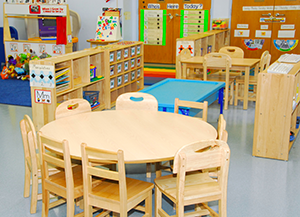 The term physical environment refers to the overall design and layout of a given classroom and its learning centers. Teachers should design the environment by organizing its spaces, furnishings, and materials to maximize the learning opportunities and the engagement of every child. To effectively do so, teachers can apply a concept known as Universal Design for Learning (UDL), which stresses that the environment and its materials in it should be accessible to everyone. Creating this accessibility might involve providing books at different reading levels, placing materials within easy reach on a shelf, or creating ample space so that a child who uses a wheelchair can maneuver around the classroom.
The term physical environment refers to the overall design and layout of a given classroom and its learning centers. Teachers should design the environment by organizing its spaces, furnishings, and materials to maximize the learning opportunities and the engagement of every child. To effectively do so, teachers can apply a concept known as Universal Design for Learning (UDL), which stresses that the environment and its materials in it should be accessible to everyone. Creating this accessibility might involve providing books at different reading levels, placing materials within easy reach on a shelf, or creating ample space so that a child who uses a wheelchair can maneuver around the classroom.
When they set out to design an effective physical environment, teachers should consider all of that environment’s various aspects. Once they have selected child-sized, age-appropriate furnishings, teachers should then think about each of the following. Click the items below to learn more.
A well-designed physical environment has different activity areas with clear, physical, and visual boundaries, defined by the furnishings and floor coverings. These furnishings and floor coverings should create spaces that are comfortable and that lend themselves to their intended purpose. For example, a block area might have bookshelves to set it off as a block center, and carpeting or foam flooring to muffle the sound when blocks fall on the floor. Also, the library area should have a soft, comfortable floor covering for young children and adults to sit on while they look at the books. When they arrange furnishings, teachers should:
- Make sure that all children are visible to adults and that adults are visible to children, to ensure proper supervision.
- Design areas with spaces for children to work and play independently or in small groups, and to gather as a community.
- Establish clear boundaries to indicate where the center space begins and ends.
- Consider the location of centers. Centers with high activity levels (e.g., block centers, dramatic play areas, music centers) should not be located close to centers with quieter activities (e.g., listening centers, computer areas).
- Consider the number and size of centers. Make sure there is enough room that children can be engaged without being crowded.
- Create cozy, private spaces. Create safe spaces where children can retreat to rest, observe, and recharge emotionally throughout the day.
Another aspect of the physical environment includes the selection and placement of materials. The selection of materials includes choosing toys and other physical objects that are age- and developmentally appropriate, as well as linguistically and culturally relevant, for the young children in the classroom. For example, the block area should include a variety of blocks to allow children with varying motor skills to manipulate them, and these materials should be placed so that they are easily accessed. Teachers should also take care when it comes to:
- Organizing materials and keeping them in appropriate places (e.g., art materials in art center, sensory table near sink), taking into consideration children’s development of independence skills.
- Providing enough materials within the centers so that children can be engaged and not arguing over limited resources.
- Having centers organized and ready to go when children arrive.
- Making sure the materials represent the various backgrounds and ability levels of the children.
- Placing heavier items on lower shelves so that children do not get hurt when they take them down.
- Providing safe play items that offer developmentally appropriate challenges to promote the growth of problem-solving skills.
- Encouraging children to help make decisions about materials.
- Rotating materials both to promote children’s interest and to keep the materials novel.
Another important aspect of the physical environment is the design and display of visual materials. Visual material— such as posters for displaying classroom rules, daily schedules, and steps to complete a routine (e.g., hand washing)—help young children to know what to do and to better understand their environments. For example, in the block area, the teacher can label the center and use visuals of the different blocks to indicate where they belong on the shelves. This can aid the children when the time comes to clean up the center. Other considerations include:
- Displaying children’s work so that they can take pride in it and can feel a sense of ownership of the room. Doing this also offers opportunities for language development: When children talk about their work or comment on other children’s work, teachers can use these opportunities to build their language skills.
- Posting visuals at the eye-level of children so that they can see them.
- Using visuals to indicate when a center is closed (e.g., visual prompts such as sheets or blankets, circles with a slash through them).
- Displaying materials that are representative of the environment’s heterogeneity (e.g., culture, disability, language, family structures).
- Labeling centers and frequently used materials in languages that represent the home languages of the children in the classroom.
- Having children bring in pictures of their families for display in the classroom so that they feel comfortable and at home in their environment.
When they design the physical environment, teachers should also consider its lighting and sound. Teachers can use lighting and sound to create a comfortable environment that is conducive to the different activities that occur throughout the day. For example, so that children can engage in both quiet and more active play activities during center time, the block area can be carpeted to reduce noise. Teachers can also keep in mind:
- Natural lighting, or light from windows, is best when available.
- Lighting can be used to create moods (e.g., small lamps in home living areas to resemble a home environment).
- Using flooring materials that muffles sound can reduce noise from active centers. Chairs with rubber leg bottoms or chairs with tennis balls over metal bottoms can also help to reduce sound, as can wall hangings, drapes, and soft furnishings.
- Because some children are sensitive to loud sounds and bright lights, teachers might need to find ways to minimize noise and to create a dimly lit space for them.
For Your Information
To help prevent problem behavior:
- Minimize large open spaces in which children can run
- Provide enough materials within the centers so that children do not have to compete for them
- Use visual and environmental cues to help children know what to do
Including Families
Teachers can collaborate with families to create a physical environment that reflects the importance of those families and that promotes a sense of belonging. They can do this by:
- Creating a parent communication board and welcome area in the room to share information
- Requesting family pictures to be displayed throughout the classroom and the early childhood center
- Asking families to provide resources that are representative of materials and objects their children use at home
- Ensuring the heterogeneity of families within the program, as well as other families throughout the world, through such things as artifacts, artwork, posters, toys, puzzles, and toy people sets
Including Children with Disabilities
Teachers need to ensure that young children with disabilities are able to fully access and participate in learning experiences. They can do this by making minor changes to the physical environment, such as:
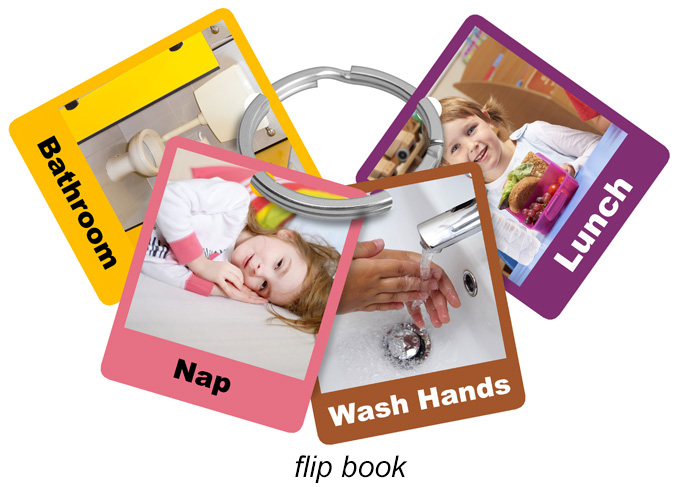 Changing or modifying the chairs to meet children’s needs (e.g., making sure the children’s feet touch the floor, using a sensory cushion- a cushion that stimulates kids who crave sensory or tactile input when sitting, having bean bag chairs available)
Changing or modifying the chairs to meet children’s needs (e.g., making sure the children’s feet touch the floor, using a sensory cushion- a cushion that stimulates kids who crave sensory or tactile input when sitting, having bean bag chairs available)- Putting squares or pictures on the floor to indicate where children should line up or sit
- Modifying materials, such as markers, to make them easier for children with motor difficulties to hold (e.g., using pencil grips)
- Providing specialized equipment (e.g., built-up handled spoons, adaptive scissors) as recommended by an occupational therapist or physical therapist to help children be more independent
- Making room for specialized equipment (e.g., walker) or assistive technology (e.g., communication board)
- Creating individualized visual materials to help children to take part in daily routines (e.g., flip book)
assistive technology (AT)
Any item, service, equipment, or product system—whether acquired commercially, specially designed, or created via changes to an existing product—that is used to increase, maintain, or improve the functional capabilities in the daily life of an individual with a disability; comes in two forms, devices and services.
communication board
A form of assistive technology, these displays consist of photographs, symbols, words/phrases, or any combination of these designed to make language visible and accessible for individuals with speech impairments.
flip book
A simple book that uses pictures or symbols to help children to participate and follow daily routines (e.g., bathroom procedures, wash hands, lunch).
Did You Know?
When they make items like pencils grips or specialized scissors available for all children, teachers avoid making certain children stand out.
Listen as Abby Green talks about how she arranges the physical environmental to help the children understand classroom expectations. Then listen as Ilene Schwartz talks about the concept of Universal Design for Learning in an early childhood environment.

Abby Green-Taylor, MEd
Teacher III / KidTalk Coach
Susan Gray School
Vanderbilt University
(time: 1:24)
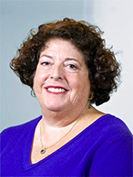
Ilene Schwartz, PhD
Professor, Special Education
Director, Haring Center for Research and Training in Inclusive Education
University of Washington
(time: 1:42)
Transcript: Abby Green-Taylor, MEd
I use environmental arrangement to show which toys are available or not available and make sure that anything visible is accessible and available upon appropriate requests. Everything else will be out of sight, so there’s nothing tempting or to promote problem behaviors. We let the children know through the environment what their expectations are. This is an activity where we’ll sit at a table, or we’ll put circles on the carpet where they’ll sit during story time. We’ll use the green squares on the floor to signify where they’ll stand to line up. That lets them know where to be, and therefore they’re successful in their environment.
The environment’s always set up where there is free play going on, as well as one to two other activities, so that children have the opportunity to choose within their environment where they can be the most successful at a given time. I don’t put any materials out that I’m not going to let them use, and so I don’t limit in that way. In the past, I’ve used a choice board where there’s four pieces of Velcro, and the children have their own owls, and that will tell them that four people can be at a given center. And that works well. In our new setup, I don’t have to limit because I always have enough choices open, and I make sure that there are enough activities going on.
Transcript: Ilene Schwartz, PhD
When we think about Universal Design for Learning, one of the most simple ways to think about that is that there are multiple ways to solve a problem, multiple ways to address a problem, multiple ways to get to the core of what we’re trying to accomplish. And that’s so important when we think about environments. The best example for this is when we think about how our society now uses curb cuts. Curb cuts and rounds were developed and are mandated for people who use wheelchairs or have other kinds of mobility challenges. But anyone with a stroller or a rolling suitcase can appreciate how much they benefit from those rounds or curb cuts. The same happens in an early childhood environment. We may put carpet squares out at circle time to help some children understand where their body needs to be, but those carpet squares can benefit all children. We may label every cubby in the classroom where everything needs to go. Those labels help children who are learning to read, those who are learning English. They can have benefits for all kinds of children. So one of the things when we think about Universal Design for Learning is that supports that we put in place for some children may benefit all children and may even benefit them in ways that we don’t understand..
Additional Considerations for Infants and Young Toddlers
 Teachers have a great deal of control over what infants and young toddlers (i.e., birth–24 months) experience in the physical environment. This is at least in part to the fact that infants and young toddlers depend on adults for their mobility. Because of this, arranging a classroom for infants and toddlers requires some specific considerations in addition to those described above. These include:
Teachers have a great deal of control over what infants and young toddlers (i.e., birth–24 months) experience in the physical environment. This is at least in part to the fact that infants and young toddlers depend on adults for their mobility. Because of this, arranging a classroom for infants and toddlers requires some specific considerations in addition to those described above. These include:
- Keeping all appropriate materials in the environment accessible to infants and toddlers so that they can explore on their own and therefore develop independence and initiative.
- Creating spaces where children can crawl and walk. Self-initiated movement is essential to a young child’s emotional development. Crawling to a desired toy and picking it up helps a young child to develop feelings of self-confidence and achievement.
- Providing safe lofts and climbing structures to support the development of motor skills.
Listen as Rob Corso explains why it is so important for teachers to create a nurturing and responsive environment for infants and toddlers (time: 1:40).

Rob Corso, PhD
Research Associate
Vanderbilt University
Transcript: Rob Corso, PhD
For infants and young toddlers, teachers really control pretty much everything they experience. So what they see, what they smell, what they touch. The key for effective environments for infants and young toddlers is really to embrace the concept of nurturing and responsive caregiving, which is a combination of relationships in the environment. The adult behaviors lay the foundation for healthy development of infants and young children. The environment and the curriculum are really blended together for how well caregivers can be responsive for the daily routines of mealtime, naptime, diaper changing. So how conducive the environment is for caregivers to be able to respond quickly and appropriately to the needs of infants and young children is really the core of what makes something a high-quality environment. In addition, for infants and young children high-quality environments have to have spaces for them to explore freely and safely in ways that are interesting and engaging, calm, and can promote interactions between adults and children, as well as children and other children. The environment for infants and young children is all about how to make sure caregivers can form close and secure relationships with the children. When adults are caring and responsive and consistent, infants and young children learn that they’re valued and that the world is satisfying and predictable, so this is really all part of the environment for infants and young children.
Research Shows
- Environments that have been carefully and effectively arranged and maintained can significantly increase positive peer-to-peer interactions.
- Using toys or activities that support social interaction (e.g., wagons, painting a mural) and grouping children with social delays with their more social peers can dramatically affect the frequency and duration of positive peer interactions.
(Bovey, T., & Strain, P. 2005)
| Examples of a High-Quality and a Less-Supportive Environment | |
| High-Quality | Less-Supportive |
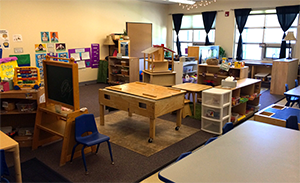 |
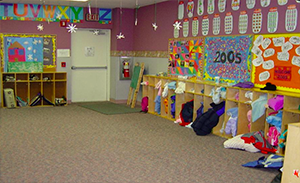 |
|
In this high-quality environment:
|
In this less-supportive environment:
* Note: This teacher may need more open space if one of her children uses a wheelchair. If this is the case, decisions regarding space must be carefully considered taking into account the children in the classroom. |
Activity
Review the picture of the preschool classroom below and discuss the strengths of the physical arrangement, as well as some possible changes you could make to improve it.
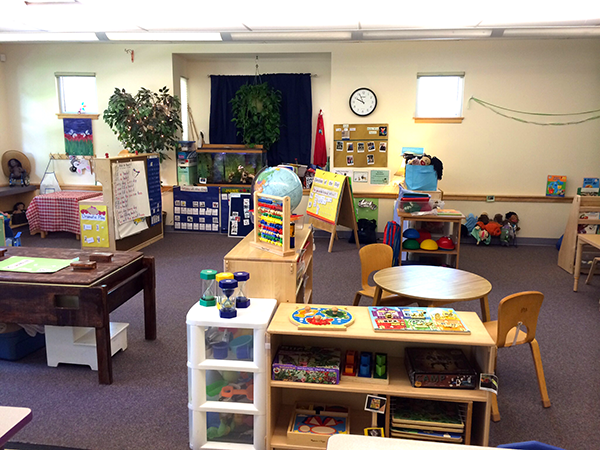
Strengths:
- Sufficient number of centers
- Utilizes the bookshelves, easels, and other furniture to break the room into small centers
- A large variety and quantity of materials are available and accessible to children allowing them to play independently or work in small groups
- Visuals placed at eye-level
Needs improvement:
- Centers could be better defined to limit open spaces
- Create a quiet area with soft materials (e.g., rug, pillows, bean bag chairs)
- Post family pictures on the walls at eye-level
- Make sure space allows for full participation and access for all children
- Add labels to identify centers
- Increase natural lighting (if possible)